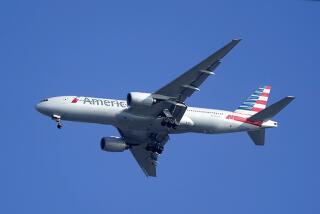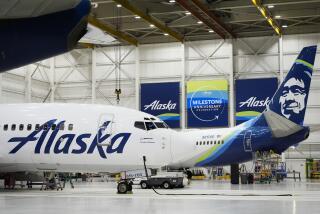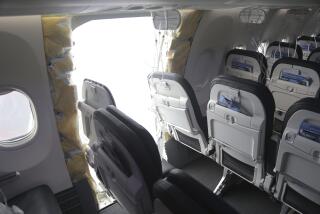Booking Safety on Domestic Flights
While the number of air traffic controllers may still be fewer than needed, the Federal Aviation Administration has taken action to make domestic flights safer.
In one move, airlines have to install more fire-resistant and slower-to-burn materials than used now in seat cushions in all planes with at least 20 seats. This new rule also covers cabin walls, ceilings, partitions, stowage compartments and other interior parts of the planes.
Airlines have until Aug. 20, 1988, to put in the new fire-resistant material.
In a second phase of this policy, airlines will have to use an even more stringent version of fire-retardant material by Aug. 20, 1990, according to an FAA spokesman.
Meanwhile, two deadlines for other safety improvements are approaching.
Airlines have to put smoke detectors in lavatories of large jets by this Oct. 29 to give pilots early warning of an in-flight fire. This rule was passed in 1985 in the aftermath of the Air Canada incident in 1983, with the airlines given 18 months to install the equipment.
Emergency Lights
Carriers have until Nov. 26 to install emergency warning lights (or as the engineers put it, a floor path proximity escape marking system) on or near floor level of passenger cabins to help guide passengers out of planes in cases where smoke has obscured the overhead lighting.
The FAA is also testing a toll-free consumer hotline number--(800) FAA-SURE--in California, Nevada, Arizona and Hawaii. You can use this number to get information or to register complaints on such subjects as airport security procedures, carry-on baggage, child safety seats, rules regarding safety for handicapped passengers, etc.
Inquiries about various FAA services including aircraft certification and maintenance procedures can also be made.
However, you canŌĆÖt use this number for complaints or problems about airline services--such areas as lost luggage, flight cancellations, ticket refunds, etc.
If you call on this hot line during office hours (8 a.m. to 4 p.m., Eastern time) someone will take the information. Chances are that you will have to be called back after the FAA can check out the carrier response. If you call after hours you will get a recording and you can leave your message.
Problems and complaints about airline service can be directed to the Department of Transportation consumer affairs office at (202) 755-2220. You can call this number and ask to be called back to avoid too large a long-distance phone bill. Generally, the DOT prefers that you try the airlineŌĆÖs consumer/customer relations department first and then call DOT if you donŌĆÖt get any satisfaction.
Requirement Sought
The FAA has been asked by the National Transportation Safety Board, a non-regulatory and independent government agency that makes non-binding recommendations, to require commuter airlines (Part 135 operators whose certificates cover planes carrying 20 or fewer passengers) to do a better job in monitoring the fuel systems of their planes.
Indicating that there have been more than 50 accidents in the last five years due to such commuter planes running low on fuel during their flights, the NTSB said the small planes used by many commuter carriers may carry the minimum amount of fuel needed for a flight, to allow more passengers and cargo to be boarded.
The board also suggested that sole reliance on electronic fuel quantity gauges can pose a problem, as these systems may indicate the amount of fuel indirectly and often inaccurately.
The board also noted that because of a lack of availability of fuel at certain locations or because of scheduling time constraints, a commuter flight canŌĆÖt always operate with the planeŌĆÖs fuel tanks filled to capacity. The result, the board said, is that often a flight operation can routinely face a potential hazard of fuel exhaustion.
The board wants the FAA to provide an increased level of surveillance of the commuter lines to make sure that the fuel measurement systems are adjusted for accuracy.
Visual Inspection
Moreover, these planes should be subject to visual inspection of fuel levels using a dipstick or dripstick, a gauge installed in fuel tanks to measure fuel quantity on the ground without using the planeŌĆÖs electrical system.
The board also recommended that the FAA require these air carriers to use calibrated dipsticks or dripsticks, when available, to verify fuel quantities on board the planes if flights are going to be flown with less than a full load of fuel.
According to the board, most manufacturers of commuter planes donŌĆÖt make such calibrated devices for the fuel systems in their planes. However, such devices are available for some makes and models of these general aviation planes through independent aircraft equipment suppliers.
The board also asked the FAA to encourage the continued general development and application of such fuel tank dipsticks and dripsticks.
More to Read
Inside the business of entertainment
The Wide Shot brings you news, analysis and insights on everything from streaming wars to production ŌĆö and what it all means for the future.
You may occasionally receive promotional content from the Los Angeles Times.










